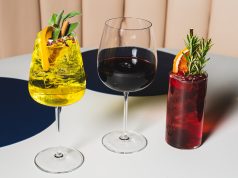
With the temperatures rising, Coloradans are reaching for unlikely refreshment: ice-cold cider. Yes, cider; a drink that was last popular when America was fighting the Civil War. Kind of makes sense if you think about it, since that was also the last time long beards were the rage. So what is driving this cider craze?
One big factor is that unlike 20 years ago when they missed the craft beer breakout, big multinational brewers are paying attention this time and aggressively entering the market with their own products. Anheuser-Busch InBev is rolling out Stella Cidre and Johnny Appleseed, MillerCoors is launching Smith & Forge, and Sam Adams has already successfully launched Angry Orchard. Their constant TV and print ads are raising awareness among consumers.
But the changing palates of American drinkers, forever altered by the craft beer revolution, has proved to be a fertile ground for smaller-scale cider makers as well.
“We are located near several breweries — Epic, River North, Crooked Stave — and we draw customers from them daily,” says Eric Foster co-owner of Denver’s Stem Ciders. “They are looking for something new and our barrel aged ciders appeal to them.”
Boulderites, too, are now seeking out ciders.
“We have seen a huge growth in our ciders over the last year, so much so that we have tripled our offerings and are on the hunt for new ciders,” says Derrick Ridge, beer manager at Hazel’s Beverage World.
But a big part of what’s interesting in that growing market is that cider’s appeal is spreading to both men and women.
“When we were planning our cidery and tasting room I was skeptical,” says Brad Page, co-owner of Colorado Cider Company. “I figured we would mostly appeal to women. I was wrong. Our tasting room is almost split 50/50 and it’s not just couples. We are pulling in millennials, boomers, heck just about anyone.”
That’s very different from craft beer, which appeals more heavily to males — 75 percent of beer drinkers are men, according to the Brewer’s Association.
The current gluten-free movement has also helped drive cider consumption as more Americans monitor their menus.
Cider, unlike beer, does not use any grains; it’s basically fermented apple juice that is classified as a wine.
“We carry one cider on tap and it does quite well for us,” says Heather Hahn, manager at Mountain Sun. “It seems like we are getting more people asking for a gluten-free option, so we always have Glider Cider on tap. Personally, it’s one of my favorites.“ Perhaps we have imported a trend from across the Atlantic. Ten years ago the United Kingdom suddenly saw a cider boom, skyrocketing from 1 percent to 15 percent market share in just a decade. Consumers ready to jump on the latest trend embraced new premium ciders that were rolled out across the U.K. starting in 2004. What was old was now hip.
Whether cider will stay on its double-digit growth is entirely up to fickle consumers. In 1978 there were 83 breweries left in America and disco was ruling the airwaves; who could have predicted that 35 years later there would be over 2,900 breweries and skinny jeans would rule the runway?
Respond: [email protected]














